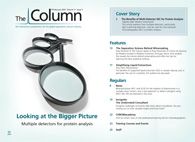Analyzing Swimming Pool Water
Pharmaceutical and personal care products (PPCPs) entering water supplies have been widely studied, but there is little information on the activity of these compounds in swimming pool water. Researchers have applied a PPCP analysis method previously developed for the detection of 32 PPCPs in wastewater to survey indoor swimming pools in the USA.
Pharmaceutical and personal care products (PPCPs) entering water supplies have been widely studied, but there is little information on the activity of these compounds in swimming pool water. Researchers have applied a PPCP analysis method previously developed for the detection of 32 PPCPs in wastewater to survey indoor swimming pools in the USA.1,2
Water samples were taken from three swimming pools in Indiana and Georgia in the USA during the winter of January 2013 and the summer of July 2014. Samples were extracted using solid-phase extraction (SPE) and subsequently analyzed using liquid chromatography tandem mass spectrometry (LC–MS–MS). N,N-diethyl-m-toluamide (DEET), caffeine, and tri(2-chloroethyl)- phosphate (TCEP) were detected at measurable concentrations. Corresponding author Ernest R. Blatchley III told The Column: “From my perspective, our results to date do not represent any cause for alarm. We did find three PPCPs (out of roughly 30 that are identif able and quantif able using Professor Huang’s LC–MS–MS method), but we do not have enough information to address the importance of these data with respect to human health. Moreover, we have essentially no information about the other PPCP compounds (or their derivatives) that could be present in pools.” - B.D.
References
1. S. Weng, P. Sun, W. Ben, C-H. Huang, L.T. Lee, and E.R. Blatchley III, Environmental Science and Technology Letters1, 495−498 dx.doi. org/10.1021/ez5003133 (2014).
2. L.P. Padhye, H. Yao, F.T. Kung’u, and C-H. Huang, Water Research DOI: 10.1016/j.watres.2013.10.070 (2014).
This article is from The Column. The full issue can be found here>>

Determining the Serum Proteomic Profile in Migraine Patients with LC–MS
April 17th 2025Researchers used liquid chromatography–mass spectrometry (LC–MS) in their proteomic analysis to compare the serum proteome of migraine patients with healthy controls and to identify differentially expressed proteins as potential migraine biomarkers.
Thermodynamic Insights into Organic Solvent Extraction for Chemical Analysis of Medical Devices
April 16th 2025A new study, published by a researcher from Chemical Characterization Solutions in Minnesota, explored a new approach for sample preparation for the chemical characterization of medical devices.











